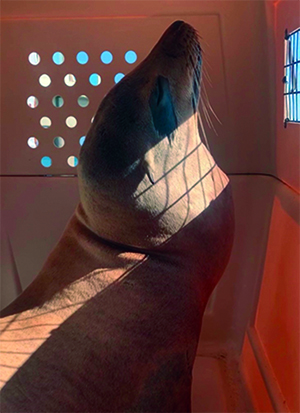Domoic Acid
By Dr. Guthrum Purdin, DVM, Wildlife Veterinarian
In mid-August, California Wildlife Center rescued a sea lion (Zalophus californianus) that had been spotted frothing at the mouth and stuporous. After capture and during transport, full seizures developed. Just a few days later, another sea lion was rescued – this one was weaving their neck and head in a serpentine motion, alternating with what’s called “stargazing” where the head points upward and back, blindly directed toward the sky. Sadly, this was the beginning of a trend, one that would reach up and down the Pacific coast.

Sea lion suffering from DA poisoning, “stargazing”
The culprit was a “harmful algal bloom” (HAB) where a type of diatom, an algal plankton called Pseudo-nitzschia australis, reproduces in massive numbers and produces a toxin called domoic acid (DA). The diatoms are eaten by shellfish and other tiny grazers who are themselves eaten by larger predators. At each step in the food chain, the toxin is concentrated in the animal’s tissues. During one of these HABs, sardines & anchovies, tasty meals for hungry sea lions, may become heavily contaminated with DA, a neurotoxin that can be fatal to marine mammals. Fish eating marine birds, like pelicans and loons, can be likewise affected. Among other properties, DA mimics a certain neurotransmitter called glutamate, activating cells in the nervous system that then can’t be switched off. It also causes calcium to flood into certain cells in the brain, especially the hippocampus and amygdala. Humans exposed to DA may develop Amnesiac Shellfish Poisoning. In animals, the brain, the kidneys, and the heart can be damaged. There is no antidote to this toxin and treatment is supportive: primarily controlling the seizures and providing fluids. Providing good healthy, DA-free food is another key component to treatment.
Problems may persist even after treatment if permanent brain damage occurs. People can have deficits in short-term memory and mood swings. Recovered sea lions have sometimes been found confused, wandering miles away from the ocean.
Way back in 1961, open ocean birds called Sooty Shearwaters appeared at Capitola near Santa Cruz, crashing into people and windows. No one knew what was causing this bizarre behavior and the upsetting event inspired Alfred Hitchcock’s classic horror film “The Birds”. HABs were rare then, but researchers now believe this was an early appearance of DA. Blooms of Pseudo-nitzschia and other toxic plankton are increasing in frequency as ocean temperatures rise. Nutrient runoff from agriculture can further compound the problem.
There are several monitoring stations up and down the coast that keep tabs on concentrations of Pseudo-nitzschia in seawater with the intent of detecting an incipient HAB before it becomes a problem for humans who consume fish and shellfish. Likewise, sea surface temperature is regularly evaluated. In 1987 hundreds of people became ill and three died after consuming DA-contaminated shellfish at Prince Edward Island in Canada. Such large outbreaks have become rare thanks to environmental monitoring. Unfortunately for marine mammals and birds, the vast ocean that is their home and larder can also be a trap when their only food sources become contaminated with toxins like DA.
For now, this year’s harmful algal bloom has passed, and rescue calls have tapered off dramatically. If you see a stranded sea lion on the beach, especially if you suspect something like DA, do not approach the animal. These are wild animals and may behave in unexpected ways. This is especially true with DA, which can cause permanent neurological damage. DA animals can be hyperexcitable and, if they feel threatened, can be very aggressive. So stay back, at least 50ft or more, and notify your local animal control agencies, lifeguards, or a marine mammal rescue organization. Report any unusual behaviors and response teams can evaluate whether the animal is in distress or merely taking a nap after a long day at sea.
